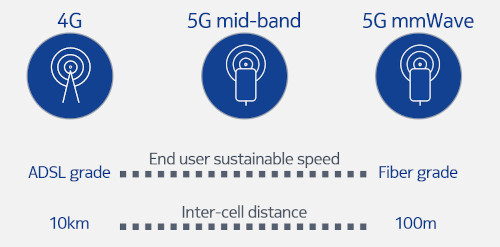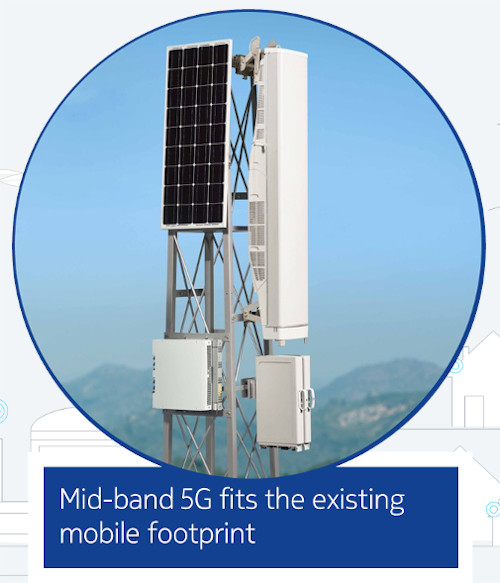FWA: A path to 5G profitability
The Difference Between Us
Before we get too excited about all the ways we can use FWA, we’d better understand what it can and can’t do.
A typical smartphone user might consume 10 to 30 Gigabits a month, while a fixed access connection with multiple simultaneous users, video, gaming and Wi-Fi offload of mobile data can consume ten times that—or more. Figure 2 shows each RAN technology’s ability to support this demand as a range from ADSL to fiber-grade services.
4G mobile networks commonly use macrocells serving many users over multiple kilometers—typically ranging to a maximum distance of 500 meters in dense urban environments and 10 to 15 km in rural areas. Maximum distance can be achieved with low-bands, but the compromise is lower speeds. Once considered high frequency, 4G in the mid-bands up to 2.6 GHz can deliver peak speeds in the hundreds of Mb/s, but these speeds will degrade with distance. In addition, radio resources are shared, so actual sustained speeds are far lower than this, which is why 4G FWA is shown on the ADSL end of the grading spectrum. Still, 4G FWA is a great tool for increasing ARPU through bundled services and for providing broadband coverage in hard-to-reach areas, particularly rural and suburban.

Figure 2: FWA technology comparison
5G at mid-bands brings much more capacity for FWA. With mid-band spectrum at 2.5 and 3.5 GHz, and up to 100 MHz of channel bandwidth and better spectral efficiency, 5G delivers 10 to 15 times more capacity than LTE networks. A mid-band 5G base station with three sectors can provide more than 500 Terabytes of data per month, supporting hundreds of FWA users. With this capacity, operators can offer Gigabit peak speeds to subscribers with sustained speeds in the 50 Mb/s range, placing it in the mid-grade range when compared to traditional fixed networks.
The added advantages of 5G in the mid-bands are cost and time to market. Signal range at these frequencies is still pretty good, meaning network densification is not required and the existing mobile footprint can simply be upgraded to support both mobile broadband and fixed wireless access. Since the radio network is still shared with mobile broadband, care must be taken to ensure that FWA, with perhaps a take-rate of 10 to 20 percent, maintains residential sustained speeds without impacting mobile broadband services. This challenge can be overcome with capacity management tools to identify and control congestion points in the network, making it possible for operators to support service level agreements (SLA) with subscribers.

Finally, there’s 5G millimeter wave operating in the 24 to 39 GHz spectrum range with as much as 800 MHz available to an operator. It’s these high frequencies that really tip the scale on bandwidth for FWA. 5G mmWave is capable of supporting speeds in the multiples of Gigabits with sustained speeds that rival that of fiber. 5G mmWave brings true fixed-grade service to 5G, but there is a cost. These signals can travel only short distances—requiring network densification—and at these very high frequencies, attenuation is high, requiring line-of-sight or near line-of-sight planning. While this impacts CAPEX and time to market, mmWave is still an attractive alternative for operators in specific regions where other spectrum options are limited or the cost to deploy FTTH is too great.
Figure 3: Mid-band 5G fits the existing mobile footprint


















